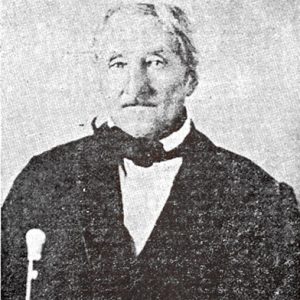calsfoundation@cals.org
Antoine Barraque (1773–1858)
Antoine Barraque established the settlement called New Gascony, one of the earliest settlements in what is now Jefferson County. He also served as a government agent with the Quapaw, whom he guided to Louisiana in 1826 after the treaty of 1824, although his efforts to ease their transition to a new land were frustrated by other government officials.
Antoine Barraque was born on April 15, 1773, in southwestern France. He was educated in Paris and served in the French army under Napoleon Bonaparte, fighting at the battles of Marengo, Austerlitz, Jena, Lodi, and Moscow. Following the end of Napoleon’s empire, Barraque relocated to Arkansas, arriving in 1816 at the age of forty-three. Living first at Arkansas Post, Barraque formed friendships with other French immigrants such as Frederick Notrebe and Joseph Dardenne. In 1817, Barraque married Maria Therese Dardenne, the daughter of his friend and a Quapaw woman; they had eleven children. Barraque maintained good relations with the Quapaw tribe but experienced conflict with other tribes, especially the Osage, who attacked a hunting expedition led by Barraque on November 17, 1823, killing seven men and capturing or destroying more than $4,000 worth of property. Barraque spent years seeking retribution, first demanding that the Osage be attacked and punished for their raid, and later seeking compensation for damages, but his requests were denied by the territorial government because he and the hunting party had encroached upon Osage lands.
In 1824, the Quapaw tribe signed a treaty exchanging one million acres between the Arkansas and Ouachita rivers for land along the Red River in Louisiana and about $26,000 in goods and cash to be paid over eleven years. Barraque was appointed by Governor George Izard as sub-agent to work with the Quapaw; he began in this post in June 1825 and supervised the migration of 455 Quapaw in January and February of the following year. Although the group arrived at the Red River on February 13, they hesitated to cross the river out of fear that the Caddo tribe already living there would not accept them; Barraque wrote that he had to force them to cross. Barraque next quarreled with Captain George Gray, the Indian agent for the Red River region. While the dispute largely concerned the question of which government agent now had authority to deal with the Quapaw, Barraque also took issue with Gray’s sale of whiskey to the Quapaw. Heckaton, leader of the Quapaw, also complained about Gray’s administration. Not only was the tribe short of provisions and uncertain about its welcome from the Caddo, but tribal leaders were offended by Gray’s treatment of them. Barraque reported his concerns to Governor Izard, and Gray also filed charges against Barraque. While Barraque and Heckaton described Gray as overbearing and insulting, Gray reported that Barraque was guilty of causing trouble by lying about the situation in Louisiana. He also said that the deprivation of the Quapaw was entirely due to Barraque’s mismanagement of resources.
When Sarasin, a Quapaw leader, chose to return to Arkansas with part of the Quapaw tribe in 1827, Gray blamed Barraque for encouraging the breach of the treaty. Evidently, no official action was ever taken against either Gray or Barraque, although Governor Izard did back Barraque’s version of the dispute, stating on April 15, 1826, that Gray should not permit Indians to purchase whiskey and adding on June 6, 1827, that gross misconduct by Gray had resulted in starvation of the Indians living along the Red River.
After his marriage in 1817, Barraque had established a settlement he called New Gascony. This settlement was part of what became Jefferson County on November 2, 1829. Barraque was at first active in county politics, and the county records were held at his estate for five months in 1832. The county seat was returned to Pine Bluff late that year by a vote of the county citizens. Barraque was the first postmaster for New Gascony when the post office was established there on November 29 of that year. After 1832, however, Barraque focused more on his cotton plantation and on his family. In 1835, he hosted traveler George W. Featherstonhaugh, who describes the estate and family of Barraque in his 1844 book, Excursion through the Slave States.
Barraque died on October 29, 1858, at the home of his daughter and son-in-law, Eliza and Ben Smith. His estate remained active for a time and was the site of a skirmish during the Brooks-Baxter War, but with the growth of Pine Bluff and the increasing importance of railroads, New Gascony eventually faded to oblivion.
For additional information:
Ashcraft, Ginger L. “Antoine Barraque and His Involvement in Indian Affairs of Southeast Arkansas, 1816–1832.” Arkansas Historical Quarterly 32 (Autumn 1973): 226–240.
Leslie, James W. “Antoine Barraque: A Southeast Arkansas Gentleman.” Pine Bluff News. June 10, 1993, pp. 1A, 3A.
Thompson, Laura Hinderks. “Historical Translation of Antoine Barraque Manuscript.” Arkansas Historical Quarterly 40 (Autumn 1981): 220–234.
“Vignette of History—Barraque: One of City’s Earliest Citizens.” Pine Bluff News. April 17, 1975, pp. 1, 3.
Steven Teske
North Little Rock, Arkansas







What happened to his portrait? It was at Pine Bluff at one time–I was told in the Simmons Bank vault.